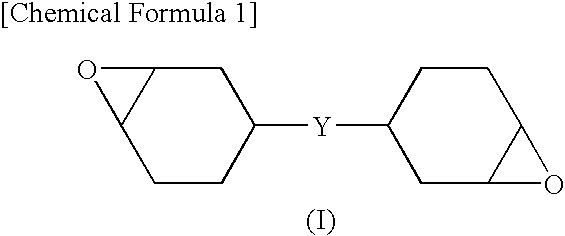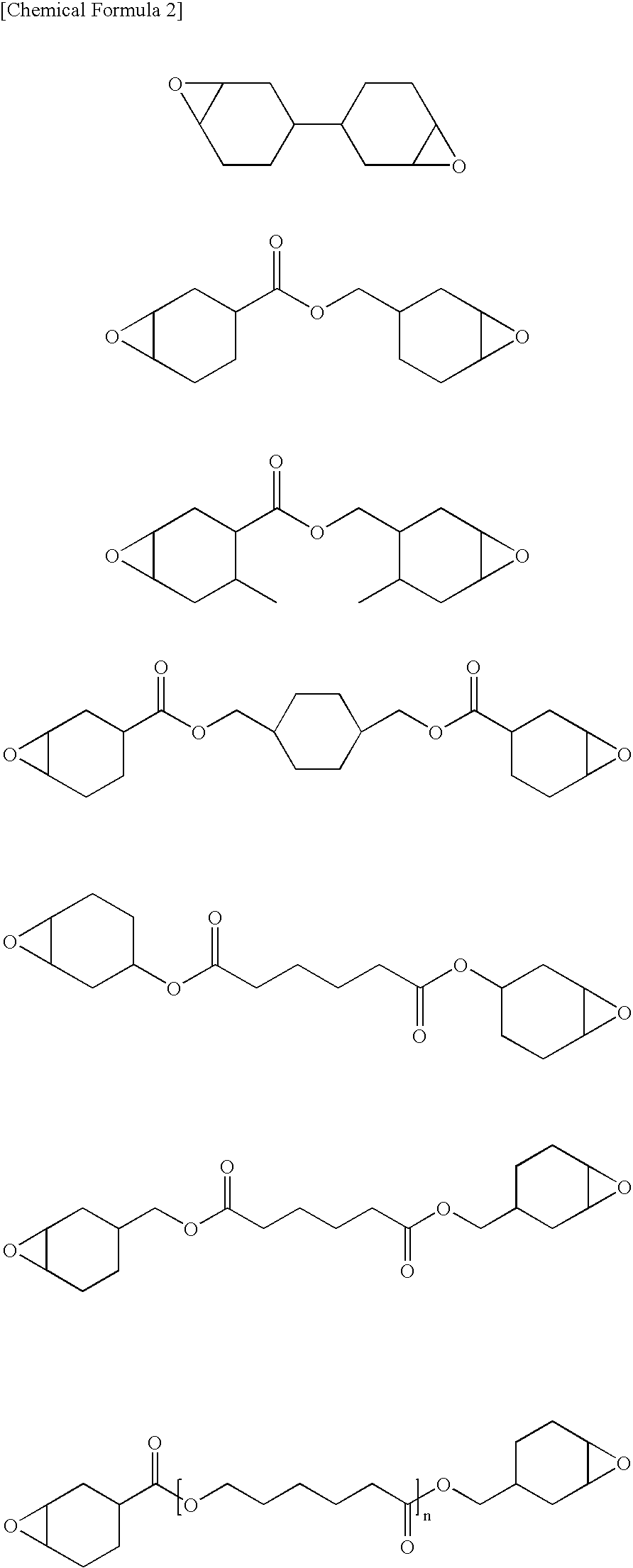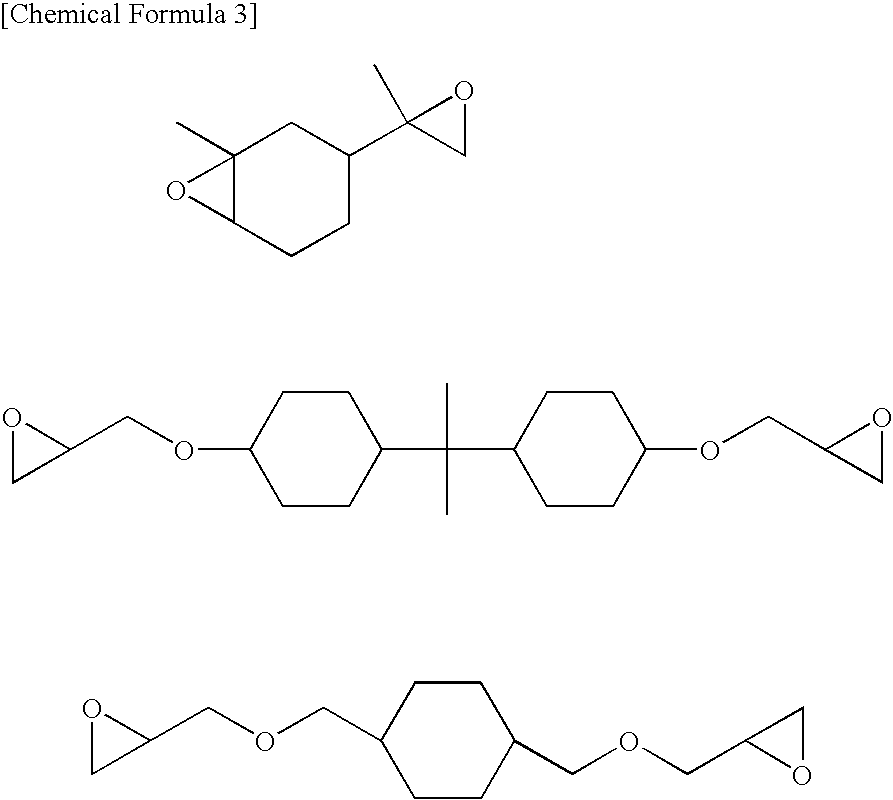Thermosetting Epoxy Resin Compositions And Use Thereof
a technology of epoxy resin and composition, which is applied in the direction of semiconductor devices, solid-state devices, semiconductor/solid-state device details, etc., can solve the problems of reducing the reliability of product electronic parts, and achieve the effects of high bending strength, low elastic modulus in bending, and high glass transition temperatur
- Summary
- Abstract
- Description
- Claims
- Application Information
AI Technical Summary
Benefits of technology
Problems solved by technology
Method used
Image
Examples
example 1
[0095] Materials used were 80 parts by weight of 3,4-epoxycyclohexylmethyl-3′,4′-epoxycyclohexanecarboxylate (a product of Daicel Chemical Industries, Ltd. under the trade name of “CELLOXIDE 2021P”, cycloaliphatic epoxy resin, liquid (25° C.), epoxy equivalent: 134) as Component (A) and 20 parts by weight of a polycarbonate diol comprising 1,6-hexanediol as one of its polyol component (a product of Daicel Chemical Industries, Ltd. under the trade name of “PLACCEL CD 205FL”, liquid (25° C.), number-average molecular weight: 500) as Component (B) both as the base resin; 103.4 parts by weight of methylhexahydrophthalic anhydride (a product of New Japan Chemical Co., Ltd. under the trade name of “Rikacid MH-700”) as Component (C); 0.5 part by weight of octanoic acid salt of 1,8-diazabicyclo[5.4.0]undecene-7 (a product of SAN-APRO LIMITED under the trade name of “U-CAT SA-102”) as Component (D); and 1.1 parts by weight of ethylene glycol (Wako Pure Chemical Industries, Ltd.).
[0096] Thes...
example 2
[0098] A liquid thermosetting epoxy resin composition was prepared by the procedure of Example 1, except for using a polycarbonate diol comprising 1,6-hexanediol as one of its polyol component (a product of Daicel Chemical Industries, Ltd. under the trade name of “PLACCEL CD 210PL”, liquid (25° C.), number-average molecular weight: 1000) as Component (B); using 70 parts by weight of Component (A), 30 parts by weight of Component (B), 87.6 parts by weight of Component (C), and 0.45 part by weight of Component (D); and not using ethylene glycol.
[0099] The prepared liquid thermosetting epoxy resin composition was cured by heating under the above-mentioned conditions and the physical properties of the cured product were determined. The resulting cured resinous product was found to have a glass transition temperature of 181° C., a light transmittance (400 nm) of 84.7 T %, a light transmittance (380 nm) of 78.9 T %, an elastic modulus in bending of 2505 MPa, a bending strength of 76.8 MP...
example 3
[0100] A liquid thermosetting epoxy resin composition was prepared by the procedure of Example 1, except for using a polycarbonate diol comprising 1,6-hexanediol as one of its polyol component (a product of Daicel Chemical Industries, Ltd. under the trade name of “PLACCEL CD 220HL”, liquid (25° C.), number-average molecular weight: 2000) as Component (B); using 75 parts by weight of Component (A), 25 parts by weight of Component (B), 96.2 parts by weight of Component (C), and 0.48 part by weight of Component (D); and not using ethylene glycol.
[0101] The prepared liquid thermosetting epoxy resin composition was cured by heating under the above-mentioned conditions and the physical properties of the cured product were determined. The resulting cured resinous product was found to have a glass transition temperature of 183° C., a light transmittance (400 nm) of 86.8 T %, a light transmittance (380 nm) of 80.5 T %, an elastic modulus in bending of 2610 MPa, a bending strength of 71.2 MP...
PUM
| Property | Measurement | Unit |
|---|---|---|
| molar ratio | aaaaa | aaaaa |
| elastic modulus | aaaaa | aaaaa |
| bending strength | aaaaa | aaaaa |
Abstract
Description
Claims
Application Information
 Login to View More
Login to View More - R&D
- Intellectual Property
- Life Sciences
- Materials
- Tech Scout
- Unparalleled Data Quality
- Higher Quality Content
- 60% Fewer Hallucinations
Browse by: Latest US Patents, China's latest patents, Technical Efficacy Thesaurus, Application Domain, Technology Topic, Popular Technical Reports.
© 2025 PatSnap. All rights reserved.Legal|Privacy policy|Modern Slavery Act Transparency Statement|Sitemap|About US| Contact US: help@patsnap.com



